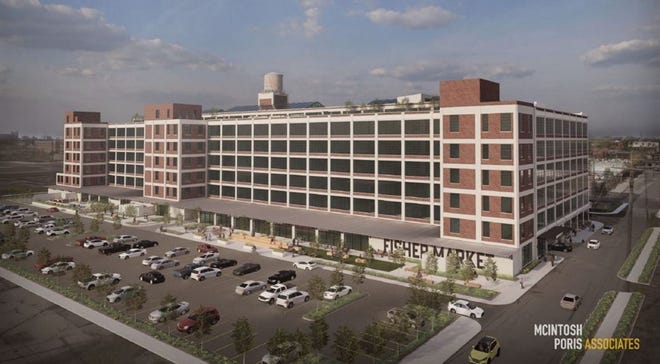
A long-empty Detroit auto body factory, Fisher Body Plant No. 21, would be transformed into more than 400 apartments plus retail space under a redevelopment plan unveiled Monday by the developers and city officials.
The $134 million project, called Fisher 21 Lofts, is to go for site approvals later this spring and could get underway late next year for a 2025 completion date.
It represents one of the most ambitious recent redevelopments of an abandoned Detroit building, especially because of its switch from industrial to residential use.
The project also is notable for its Black-led development team of Gregory Jackson of Jackson Asset Management and Richard Hosey of Hosey Development, who will work in partnership with Lewand Development.

The six-story, 600,000-square-foot former factory at 6051 Hastings St., near Interstate 75 and Interstate 94, has been empty since 1993 and owned by the city since 2000.
“It’s basically been abandoned for 30 years,” Detroit Mayor Mike Duggan said at a news conference Monday inside Detroit police headquarters. “People in the city know it as the place where when you go to the 94 and 75 interchange, it’s the big white building with the graffiti all over it.”
The building was designed by the old Detroit architectural firm Smith, Hinchman & Grylls and opened in 1919 as the Fisher brothers’ 21st production plant. The site initially made auto bodies for Cadillacs and Buicks, and later was used by General Motors until 1984.
The building went on to be owned and operated by Cameo Color Coat, which, in 1990, transferred ownership to Carter Color Coat for its industrial paint operations. Carter Color Coat declared bankruptcy and abandoned the building in 1993, according to background information on the property by the Environmental Protection Agency.

To make the conversion into Fisher 21 Lofts, the developers will take the large factory floorplates and cut three atriums, each the width and length of a city side street, through floors three through six.
The project would create 433 for-rent apartments, with 20% set aside at below-market rents for income-qualified residents.
There also would be 28,000 square feet of commercial and retail space and 15,000 square feet of co-working space. Future residents would park on adjacent lots at 991 and 666 Harper.
The mayor said that after failing to find much interest in the abandoned plant from auto suppliers or other potential industrial users, he was leaning toward demolishing the building. But then Jackson stepped forward with the plan for an apartments conversion.
“He said, ‘You’re looking at this all wrong,’ ” Duggan recalled. “Nobody would build a plant with multiple levels anymore. (Being) this close to downtown, Midtown and New Center — this is housing.”
“If it had been anybody else, I would have gone forward with the demolition,” the mayor added. “But Greg Jackson’s credibility as a business person, in running the Lafayette Towers apartments, in knowing real estate (is) the reason we did not demolish this building three years ago.”
The project is still subject to multiple approvals, including for the sale of the city-owned land to the developers.
Duggan said the proposed sale price is under $1 million, and estimated that the city would have otherwise needed to spend $5 million to $10 million to demolish the building if not for the proposed redevelopment.
Because of the extensive cleanup work, the project’s financial viability depends on getting approvals for several local- and state-level redevelopment incentives, including a tax freeze, historic tax credits and long-term brownfield tax-increment financing.
There already have been significant environmental reviews and structural testing to confirm that the building is sound and safe for future habitation, according to Kevin Lewand of Lewand Development.

Detroit City Council President Mary Sheffield praised the developers for their vision.
“The plan to redevelop a 25-year-old symbol of decay, of systemic disinvestment and of blight quite frankly, to now be a symbol of hope, of opportunity, of progress, really signals where we are as a city and the momentum that is taking place,” Sheffield said.
Fisher Body Plant No. 21 last made headlines in the mid-2010s when the owner of a renowned Berlin techno music club called Tresor expressed interest in buying it and making it into a cultural and nightclub space with a European-style hostel.
Club owner Dimitri Hegemann toured the building, but ultimately didn’t buy it. He later made plans with the owner of the Packard Plant, Fernando Palazuelo, to build his hostel and nightclub space there as part of the Packard Plant’s extensive redevelopment plan.
However, Palazuelo’s Packard Plant dream was recast last year to likely involve demolition and new industrial warehouses, rather than offices and cultural space.
Sections of the Fisher Body Plant were damaged in a suspected October 2014 arson fire in which a Detroit firefighter was knocked unconscious after jumping from a 40-foot-high aerial ladder bucket as part of the structure collapsed.
ContactJC Reindl: 313-222-6631 or jcreindl@freepress.com. Follow him on Twitter @jcreindl. Read more on business and sign up for our business newsletter.

